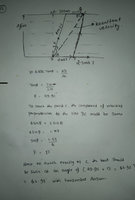Haroon has a remote control electric toy boat that can travel at 6 m/s and wants to steer it across a 250 m wide river to his friend's dock. His friend's dock is on the opposite side of the river, 210 m downstream from looking straight across. There is a current of 2.5 m/s.
a) Draw a vector diagram for this situation and determine the heading that the boat should be steered at relative to the closest shoreline.
b) Determine the time it will take to cross the river.
a) Draw a vector diagram for this situation and determine the heading that the boat should be steered at relative to the closest shoreline.
b) Determine the time it will take to cross the river.

